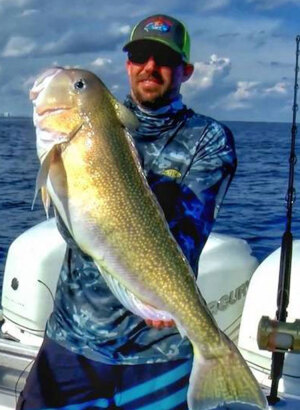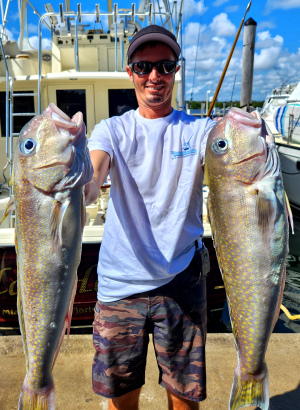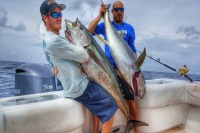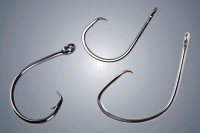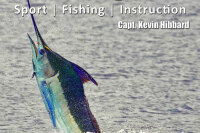Tilefish are a popular species for fishing during sunny days, feeding on various crustaceans and crustaceans. Their meat has a shellfish-like texture and flavor, similar to lobster or crab. They prefer soft sand and mud, making deep dropping easy. The fish is popular in Northeast, Florida, Gulf, and Texas, with ideal depths of 600-800 feet in South Florida.

Tilefish - Fishing for Lobster By Another Name
Article Summary:
- Understanding Tilefish: Describes the unique characteristics of tilefish, their habitat, and why they are compared to lobster in taste and texture.
- Fishing Techniques: Explores the simplicity and effectiveness of deep dropping techniques for catching tilefish, with a focus on the ideal environments and conditions.
- Tilefish Habitat: Discusses the bottom dwelling nature of tilefish, their preference for soft mud and sand, and how this influences fishing strategies.
- Tilefish Profile: Details the physical appearance and life cycle of tilefish, highlighting their iridescent colors and lifespan.
- Bait and Tackle: Offers advice on the best baits and rigs for catching tilefish, emphasizing the importance of using smelly, oily baits.
- Drift Fishing Strategies: Outlines techniques for effectively covering ground and locating tilefish burrows, including how to manage drift in different current conditions.
- Constructing Tilefish Rigs: Provides step-by-step instructions for building effective tilefish rigs, suitable for various deep dropping scenarios.
- Educational Resources: Recommends additional resources, such as videos and tutorials, for those looking to deepen their understanding of tilefish fishing.
When the sun is on its high arch in the sky, tilefish will be on the chew. 10 AM to 3 PM is a great window to be targeting the species. Sunny days will find the bite being way better than overcast days. During this 10-3 stretch of day, tilefish will be feeding on the bottom, eating lobsters, shrimp, crabs, clams, other tilefish and any assortment of crustaceans creeping along in the deep. These bottom feeders have strong teeth, which allow them to easily crunch down on the shrimp, crabs, shellfish, sea urchins and other life that lives within their domain.
As a result of eating all these delicious sea creatures, the meat of a tilefish has an unusually shellfish like texture and flavor. The meat is mild and sweet, with a firm quality, similar to lobster or crab. Tilefish are commonly referred to as the poor mans lobster or poor mans grouper. It's true. The clean, white, flaky fillets of the tilefish with their wonderful flavor profile, make tilefish damn good eats.
Fishing for Tilefish
Fishing for tilefish is all about deep dropping. Because of where they live, tilefish are the easiest fish to drop on. This is not technical fishing. Just drop your lead all the way to the bottom and bounce you rig, as you drift with the current. Without current, it is even easier. You can use your engines to bump along and manage your drift. It's damn near fool proof. Tilefish prefer soft sand and mud, into which they burrow and build their home. So, there’s little chance of getting snagged. The key is to keep your baits on or very near the ocean floor. If y0u loose contact with the mud, reel your line up a bit and drop it back down. This is not difficult fishing. The hardest part of tilefish fishing is finding the good mud. Even that will not tax your capabilities, if you can read a bottom machine.
The simplicity of deep dropping for tilefish has made this lovely fish very popular amongst anglers from the Northeast down around Florida, up into the Gulf and over to Texas. While northern fishermen have long runs of up to 90 miles, in South Florida you can reach the ideal depth of 600 to 800 feet in a few short minutes. The trade off is that the further south you go, the smaller the average fish gets.
Along the southeastern coast and in the Gulf, tilefish dig rabbit like burrows to hide in. The fish will constructs impressive rubble mounds over its burrows. They will not venture far from the safety of their refuge. When approached closely or frightened, tilefish will quickly retreat into the burrow, which is located near the apex of the mound. Even though they are a solitary fish, tilefish sometimes congregating in tightly-packed colonies or small groups at depths where the green muddy bottom is prevalent, near the continental slope. This is pretty much the only area you’re going to find them.
The key to tilefish fishing is finding this zone, where they find comfort. In order to do this, you need to be able to distinguish the density of the bottom. You can utilize bathymetric charts to locate an area in in the ideal depth range where the contour lines are further apart. This will indicate a flat area and that’s where you want to start dropping. On your depth finder, you will see a layer or lines that looks sort of broken up with a layer of green haze above the bottom. This indicates soft mud. The tell tale sign is when you lead hits the bottom and gets stuck. You may think you are hung, but then the lead will pop loose.
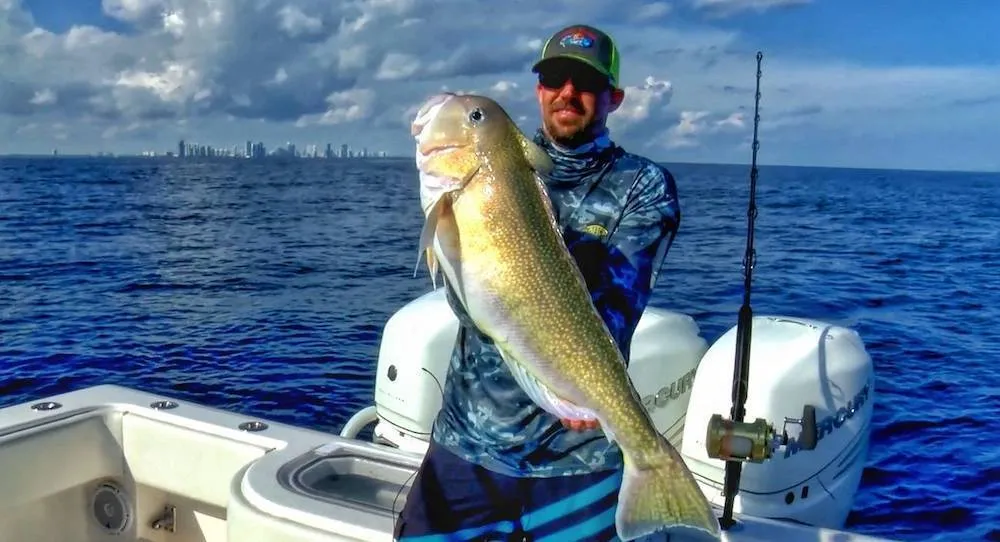
Profile in Color
Iridescent blue-green backs, spotted in bright yellow and gold, bellies of white, and rosy heads with blue under the eyes, paint the tilefish with an air of royalty. The golden tilefish even has a large crest on its head. It always amazes me, the beautiful colors on deep water fish and tiles will be outdone by no rival. The colorful tilefish is a slow-growing species, living up to 50 years and reaching 40 plus inches, although average size will around 20 inches. Size depends on where you are fishing. The more Northerly you travel in the Gulf Stream, the bigger the tiles get, according to lore.
Tilefish are fecund, releasing upwards of 8 million eggs during the spawn. That makes for a lot more tiles. Tilefish will spawn from March through November, peaking in June in the Mid-Atlantic and from January through June in the South Atlantic and Gulf of Mexico, peaking in May. The area in which tilefish range is so expansive and the spawn so prolific, that even with heavy commercial fishing, the fishery quickly rebound with regulation. Nothing is guaranteed, but recreational fishermen looking for the fish usually find them.
Deep Dropping for Tiles
Given the nature of the substrate you are dropping baits onto, there is very little risk of getting hung up, making fishing for tilefish one of the easier forms of deep dropping. Dropping baits 500 and well more feet to the bottom may at first appear a little difficult, but it really isn't. The biggest challenge you could face is the current, how much there is and how you contend with it. The most obvious way to deal with current is with weight. The more you use, the more direct path you get to sea floor.
In S. Florida, where the Gulf Stream chugs along 2-3 knots on the regular and faster, at times, 5-8 lbs of lead works well. With less current, you can use less lead. Deep dropping is an interesting calculus with current. The more you have, the more your line will be pushed in the direction of the flow. So, even though you line may appear to be going straight down into the water, there is a bow in the line below the surface. Generally, it makes hitting an intended target a little more difficult. With the tilefish grounds though, there is not much to screw up, other than your drift line.
As you are dropping on spot after spot, the idea is to bounce your lead on the bottom, as if you were knocking on the door of the tilefish burrow. Boom. Boom. Boom. This vibration from your lead hitting bottom, getting stuck and then pulled out stirs the fishes curiosity. They can't resist seeing who's out there. Strong lateral lines, great vision and sense of smell make the tilefish a viscous proximity predator, but one the is completely susceptible to your presentation. They may not reach out very far to eat, but if you waft your tasty morsel past their front door, it's getting eaten. Tilefish are lethal within a very tight radius to their home. With so much viable bottom real estate, finding productive areas makes tilefish fishing well worth it. Keep this in mind. If you are in an area of soft bottom and you send your lead down and it seems to have hung on something, wait a few seconds. If you then notice the rod tip stand up, this is a great indication that you are in the good mud.
Tilefish Bait
It may be that keen sense of smell that drives the bait choices that seem to work the best. Anything oily and smelly is on the menu. Think fishy, stinky, nose curling and you're on the right track. Bonito, tuna, mackerel, barracuda and squid all work very well. I don't know about you, but I am not using my tuna for bait. Nonetheless, squid is available most any time and works wonders. You will want to put a nice chunk of bait on the hooks. A solid two inch piece of fish or a whole bait squid is good. Be sure to secure the bait well to the hook. Tilefish have powerful jaws and lots of teeth that they use to pulverize shell fish, so getting the bait off is not a difficult task.
Drift Fishing
By prop of by current, given the expansive area that makes for fertile burrowing and a tendency to construct colonies of burrows, covering ground greatly enhances your opportunities to find tilefish. This is a fish that will not be very far, at all, from its burrow, so you will need to move from burrow to burrow. Essentially what you are doing is drifting your way along a stretch of the bottom where tilefish like to live and putting your baits in front of as many fish as possible.
If you are unsure where to start the prospecting process, get good chart book and take a gander at how the contour of the sea floor is laid out. Look for areas in the tilefish depth range, for your area. Look for lines that are spaced a little further apart. Some maps will actually be marked “grn mud,” which indicates that green muddy bottom.
Once you have pinpointed the areas you want to fish, check the current. If there is very little current, you will simply drive the boat on a course that stays in the green mud zone, as you send baits to the bottom. If, however, you have 2, 3 or even 4 knots of current, you job will be how best to manage your speed over ground. IF you drift too fast, the tilefish may not have time to find the bait before it is gone. In this case, driving into the current and drifting backwards will help slow your drift. This is called stemming the tide. By doing this, you can keep your lines vertical from the rod tip to the water. In all deep dropping, the idea of keeping your lines straight up and down is key. This really helps prevent driving over your line and allows you to see the bite better.
Once you start getting bites, mark that area, so you can swing back around and drift the area again. It can take a couple of drifts to get the fish chewing, so don't hesitate to hit an area where you got a bite again. Many times, you will find that bigger fish will come late to the party.
The Rig
There are all sorts of deep drop rigs that you can use for tilefish fishing. Several companies make off the shelf rigs that will work fine. Making your own is really not that hard. From your mainline, 50-65 lb braid is fine, attach a 200 lb snap swivel. Clip a water activated strobe here, also. From there you can attach a 150 lb ball bearing swivel that will then be tied to a foot and a half or 130 lb monofilament. You can add more swivels in-line from the snap. It can't hurt. You just want to prevent the rig from twisting. At the end of that first length of mono, add a 130 lb three way swivel. To this you will add you first dropper line. This is the line that a hook will go on and should be one and half feet in length. An 8/0 circle hook works fine. From this three way swivel add a two and half foot length of 130 mono to the next three way swivel. To this swivel, add a 2 foot dropper line and another 8/0 hook. Then, add a 2 foot section of mono to the lead. You can add more hooks, to make you rig longer, if you like. Two hook rigs, three, four, or more are common. It is just a matter of what you are comfortable with.
I will reverse the rig starting from the lead, to give you a different perspective. From the lead, add a 2 foot length of 130 mono. Attach you three way swivel. You can attach it by tying it on or crimping it. On this three way swivel, attach a 2 foot dropper line and hook. Add another two and half foot length of mono and affix another three way swivel. To this, you will add a one and a half foot dropper line and hook. Add a foot and a half of mono here, to which you will add a ball bearing swivel. You main line will have the snap swivel and light. Clip the ball bearing swivel to the snap swivel and you are ready.
If you want to learn more about tilefish fishing, check out our videos on Tilefish. We discuss finding good mud, the baits that work and hooking them on, so they don't get easily pulled off. You will see demonstrations on how to drop and keep the baits on the bottom. Recognizing the bite can be tricky, so you will see several examples of what to look for and how to react. The drift and how to deal with current is covered, as well. There is a good bit of high level actionable information to learn from, so you can go out and catch more tilefish.

